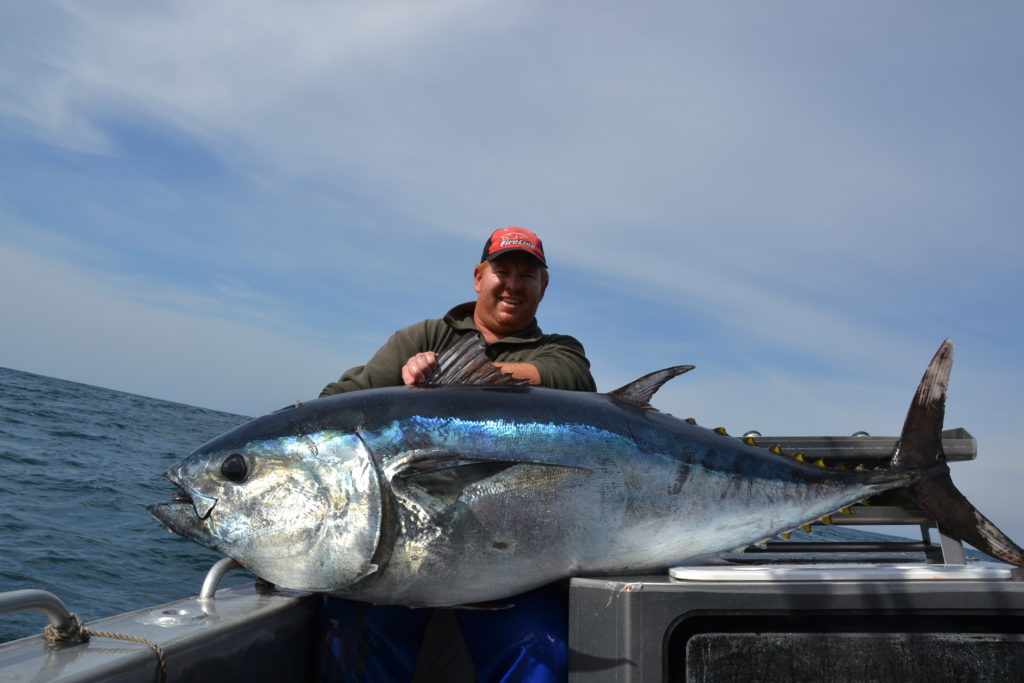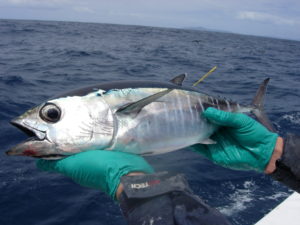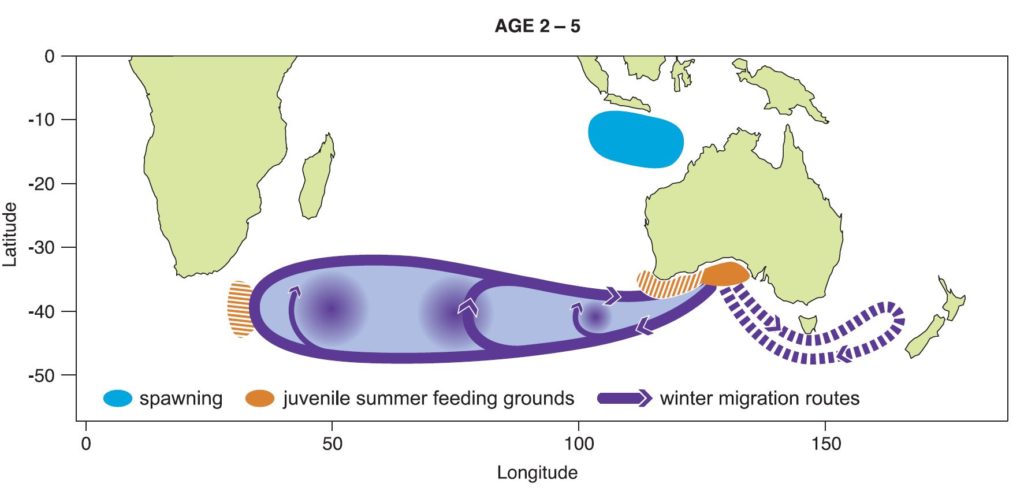
Blimey that’s a big bluefin! Matt Bell with the 175 cm southern bluefin tuna he caught near Port MacDonnell. Image: Matt Bell and Dennis Heinicke
We have been reunited with an old friend. We met a long time ago, 22 years in fact, and we certainly left our mark during that first meeting. Now with a long passage of time behind us, we are keen to find where she has been all this time.
We are, of course, talking about this stunning southern bluefin tuna (SBT). Tagged in 1993, the fish was reeled in by avid fisherman Matt Bell with the help of Skipper Dennis Heinicke, near Port MacDonnell last week.
We first met ‘Bluey’ when she was approximately two years old. At the time, our scientists were out on the open oceans teaming up with the Commission for the Conservation of Southern Bluefin Tuna to tag over 11,000 SBT in the Great Australian Bight (GAB).

Here’s looking at you kid. An example of the small yellow tags poking out of the dorsal fin of a juvenile SBT. This isn’t Bluey, but you can appreciate how big she has grown.
Thanks to our citizen scientists Dennis and Matt, Bluey is back, and my how she has grown. The fish has more than doubled in size. She weighs 102 kgs and has had a decent growth spurt, from 60 cm to a behemoth 191 cm total length – or if you are a purist for measurements, her ‘fork length‘ is 175 cm (that’s still 5’ 7”, or taller than Tom Cruise).
Other than growing up to be taller than Hollywood celebrities, what does an SBT do in twenty years? From what we can tell, Bluey has led quite an interesting life.
We know that Bluey spent large parts of her life travelling the southern seas. And although she was reeled in 800 km east of where she was originally caught and tagged, we know from our other more sophisticated SBT tags that Bluey has been undertaking large migrations. As a juvenile, these migrations took her from the GAB to the Indian Ocean; upon maturing, she travelled between the Southern Ocean and the Indian Ocean, just south of Indonesia. It is here that adult SBT spawn each year.

Schematic of juvenile SBT migrations, showing the distance and patterns of the SBT movement in their youth.
Dennis and Matt have not only been helping our researchers by reporting and returning Bluey’s tags, but they have also collected some very important samples of the fish. By looking at Bluey’s otoliths (deposits in the ear) we can determine and verify her age. By looking at her ovaries we can determine her sex and reproductive history. And by analysing the chemical composition of Bluey’s muscles, we can know her diet.
Why are we so excited about this find? Because we rely on the cooperation of commercial and recreational fishers to find the tags, and in the vastness of Southern Ocean, finding a tagged fish after such a long time is like finding a needle in a haystack.
Remember, Bluey doesn’t have a social media profile (MySpace wasn’t even around back then) so checking in and finding out what’s been happening is a bit more complicated than trawling through her Facebook Timeline. Now that the tags and the fish are back with our scientists, we have an opportunity to learn more about the life of this particular bluefin and the SBT population in general.
These insights, will help with our ongoing research and conservation efforts in our southern oceans. The information is invaluable as we seek to understand how exploration and extraction activities in the ‘Bight’ might affect SBT populations.
We will now add Bluey’s profile to the data we’ve gathered after almost 50 years of archival tagging efforts.
We’ve recently been tagging juvenile SBT (similar to the two year old Bluey) with ‘smart’ archival tags that gather detailed data on the movements, diving behaviour, habitats, and feeding of the SBT. By comparing the data from these tags to similar tags we deployed during the 1990s and 2000s, we can investigate the impacts of oil and gas exploration and extraction on juvenile SBT during the period they ‘summer’ in the GAB.
To learn more about Bluey, you can listen to a recent interview Dr Campbell Davies conducted with ABC Radio Hobart where he speaks more about tagging and our research. And if you would like more information about our SBT tagging efforts you can visit our fisheries page.
If you consider yourself a budding citizen scientist, and you do happen upon one of our tags during your fishing adventures, we’d love to hear from you. There are prizes and giveaways for returned tags, plus the gratitude of our scientists and the knowledge you are furthering our understanding of these incredible creatures.
Information on how to return tags to us and the details we need are in the form below.
To the citizen scientist go the spoils. Details of the rewards and information you’ll need to help us with our Southern Bluefin Tuna tagging program.



3rd May 2015 at 9:33 am
Fantastic work. Just wondering if this fish was small for a 20 year old. Great to see the tagging work that so many anglers do give worth while results.
SBT are not available to purchase in Australia. 99% is exported straight away. We catch the highest amount of all countries. SOme is available in high end restaurants but thats about it.
If you want to eat it you have to catch it. The SBT has recovered very well but still has a way to go. Recreational fishing is fully sustainable.
4th May 2015 at 10:36 am
Thanks for the comment Dexter. The fish is ‘average’ compared to other observed adults. Adults SBT can range in size from ~140 to ~220 cm, with most fish seen on the spawning ground (and therefore actively reproducing) ranging from ~140 to ~190 cm. This fish was 175 cm (fork length) so she sits somewhere in the middle.
Cheers,
Adam
29th April 2015 at 12:33 am
The government needs to employ a better way to study animals than by encouraging people to kill them and rewarding and celebrating them for doing so.
5th May 2015 at 11:52 am
So you support large-scale clear felling and burning of forests, wholesale killing of all the animals who live in them, creation of sterile monocultures, depletion and destruction of the soil which constitutes the greatest terrestrial sink for sequestering carbon, unsustainable irrigation practices and loads of industrial chemical fertilisers and pesticides, as opposed to living off and preserving a fantastically diverse ecosystem.
5th May 2015 at 1:46 pm
well said George – sustainable wild
fishing is also the most carbon efficient form of food production on the planet so its opponents are clearly climate change deniers as well…
5th May 2015 at 4:05 pm
What impressive deductive abilities! All of that derived simply from an objection to killing a mature, reproducing female of an endangered species.
6th May 2015 at 12:55 am
Far more environmental damage and animal harm is caused by a nonvegan diet than by a vegan one. This includes the vast amount of land cleared and crops grown to produce feed for farmed animals, the immense amount of fuel consumed and pollution produced by fishing vessels, etc.
Even if there were such a thing as sustainable wild fishing (which is delusional), fishing is always grossly inhumane.
27th April 2015 at 12:37 pm
It would have been wonderful if this stunning tuna had been returned to the sea to continue with its travels
2nd May 2015 at 11:26 am
So people should not eat fish?
4th May 2015 at 10:24 am
Right, not if they don’t need to, and the vast majority of people don’t. All of the nutrients we need to thrive can be obtained more healthfully, humanely, and environmentally responsibly from plant sources.
Science has shown that fish suffer fear and pain, and needlessly harming animals for food or fun or anything else is animal abuse.
Eating fish is also a health hazard in the form of mercury -tuna are particularly high in it- dioxins, PCBS, parasites, cholesterol, saturated fat, etc., etc., etc.
Government should be explaining this to people and urging them to opt instead for a plant-based diet. Not rewarding people for harming wildlife.
26th April 2015 at 5:25 pm
Sad to see such a beautiful creature killed for some angler’s jollies despite the important information gathered.
27th April 2015 at 6:03 pm
….so I gather you don’t eat….
28th April 2015 at 10:10 am
Great work by CCSBT and CSIRO. You have managed to use ignorant fisher human behaviour into understanding something of BF Tuna behaviour. Science has to communicate the importance of conserving species to a public which is unaware of the global extinction event currently taking place.
5th May 2015 at 3:50 pm
…so I gather you’ll eat anything…
5th May 2015 at 11:43 am
Agree with you entirely Andrew
26th April 2015 at 2:40 pm
Reblogged this on The Sponge Garden.